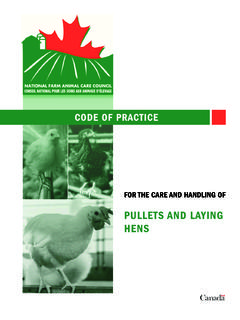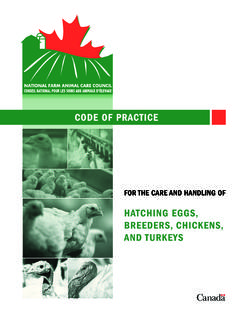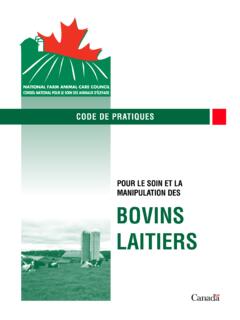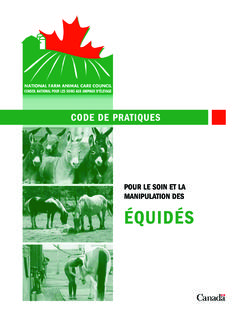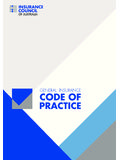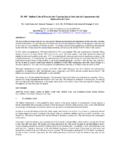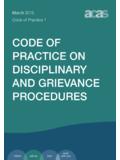Transcription of Code of Practice for the Care and Handling of Sheep
1 FOR THE care AND Handling OFSHEEPCODE OF PRACTICECODE OF Practice FOR THE care AND Handling OF Sheep - 2013iiISBN 978-0-9919585-8-0 (book) ISBN 978-0-9919585-9-7 (electronic book text)Available from: Canadian Sheep Federation 130 Malcolm Road, Guelph, ON N1K 1B1 CANADA Telephone: 613-652-1824 / 1-888-684-7739 Fax: 613-652-1599 Website: Email: information on the code of Practice development process contact: National Farm Animal care Council (NFACC) Email: Website: Also available in French Copyright is jointly held by the Canadian Sheep Federation and the National Farm Animal care Council (2013)This publication may be reproduced for personal or internal use provided that its source is fully acknowledged.
2 However, multiple copy reproduction of this publication in whole or in part for any purpose (including but not limited to resale or redistribution) requires the kind permission of the National Farm Animal care Council (see for contact information).AcknowledgmentFunding for this project has been provided by Agriculture and Agri-Food Canada through the Agricultural Flexibility Fund, as part of Canada s Economic Action contained in this publication is subject to periodic review in light of changing practices , government requirements and regulations. No subscriber or reader should act on the basis of any such information without referring to applicable laws and regulations and/or without seeking appropriate professional advice.
3 Although every effort has been made to ensure accuracy, the authors shall not be held responsible for loss or damage caused by errors, omissions, misprints or misinterpretation of the contents hereof. Furthermore, the authors expressly disclaim all and any liability to any person, whether the purchaser of the publication or not, in respect of anything done or omitted, by any such person in reliance on the contents of this image copyrights: Aveley Ranch, BCCODE OF Practice FOR THE care AND Handling OF Sheep - 20131 Table of ContentsPreface ..3 Introduction ..5 Glossary ..7 Environmental Introduction.
4 High Temperature, and Humidity, and Provision of Shade .. Provision of Shelter during Cold and Windy, and Cold and Wet Conditions .. Housing and Handling for all Sheep .. Temperature, Humidity and Air Quality .. Social Environment and Enrichment .. Lighting .. Bedding and Manure Management ..18 Feed and Nutrition and Feed Colostrum Consumption .. Artificial Rearing .. Water ..23 Health Relationship of Animal Health to Animal Stockmanship Skills Related to Animal Health and Welfare .. Veterinary care and Flock Management Programs .. Sick, Injured or Cull Animals .. Fly-Strike.
5 Parasite Control .. Lameness ..31 Husbandry Handling , Grouping and Moving Identification .. Predation Control .. Shearing and Crutching .. Hoof Trimming .. Castration .. Tail Docking .. Mulesing .. Dehorning/Horn Trimming .. Breeding .. Pregnancy, Lambing and Neonatal care .. Dairy Sheep Milking Procedures .. Dairy Sheep Early Weaning of Lambs ..48 Section 1 Section 2 Section 3 Section 4 Section 5 code OF Practice FOR THE care AND Handling OF Sheep - Pre-Transport Decision Making .. Fitness for Transport .. Arranging Transport .. Preparing Sheep for Transport .. Loading and Unloading.
6 Criteria for Euthanasia (Decision Making) .. Methods of Euthanasia .. Confirmation of Death ..56 References ..58 Appendices:Appendix A - Livestock Safety Index Chart ..62 Appendix B - Body Condition Scoring ..63 Appendix C - Accessing Veterinary Services ..66 Appendix D - Individual Examination and First Aid ..67 Appendix E - Understanding Sheep Behaviour ..69 Appendix F - Tail Docking ..71 Appendix G - Lambing and Neonatal care ..72 Appendix H - Guidelines for Dealing with Compromised Sheep ..81 Appendix I - Livestock Transport Consignment Form ..83 Appendix J - Signs of Pain in Sheep .
7 84 Appendix K - Example of Decision Tree for Euthanasia ..85 Appendix L - Euthanasia ..86 Appendix M - N - Summary of code Requirements ..90 Section 6 Section 7 code OF Practice FOR THE care AND Handling OF Sheep - 20133 PrefaceThe National Farm Animal care Council (NFACC) code development process was followed in the development of this code of Practice . This code of Practice for the care and Handling of Sheep replaces its predecessor developed in 1995 and published by the Canadian Agri-Food Research Council. The NFACC code development process aims to: link Codes with science ensure transparency in the process include broad representation from stakeholders contribute to improvements in farm animal care identify research priorities and encourage work in these priority areas write clearly to ensure ease of reading, understanding and implementation provide a document that is useful for all stakeholders.
8 The Codes of Practice are nationally developed guidelines for the care and Handling of farm animals. They serve as our national understanding of animal care requirements and recommended practices . Codes promote sound management and welfare practices for housing, care , transportation and other animal husbandry practices . Codes of Practice have been developed for virtually all farmed animal species in Canada. NFACC s website provides access to all currently available Codes ( ).The Codes of Practice are the result of a rigourous code development process, taking into account the best science available for each species, compiled through an independent peer-reviewed process, along with stakeholder input.
9 The code development process also takes into account the practical requirements for each species necessary to promote consistent application across Canada and ensure uptake by stakeholders resulting in beneficial animal outcomes. Given their broad use by numerous parties in Canada today, it is important for all to understand how they are intended to be - These refer to either a regulatory requirement, or an industry imposed expectation outlining acceptable and unacceptable practices and are fundamental obligations relating to the care of animals. Requirements represent a consensus position that these measures, at minimum, are to be implemented by all persons responsible for farm animal care .
10 When included as part of an assessment program, those who fail to implement Requirements may be compelled by industry associations to undertake corrective measures, or risk a loss of market options. Requirements also may be enforceable under federal and provincial regulation. Recommended practices - code Recommended practices may complement a code s Requirements, promote producer education and can encourage adoption of practices for continuous improvement in animal welfare outcomes. Recommended practices are those which are generally expected to enhance animal welfare outcomes, but failure to implement them does not imply that acceptable standards of animal care are not met.


